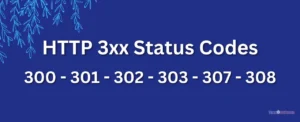As a beginner in web development, you might have encountered mysterious error codes while working on your projects. Fear not! In this blog post, we’ll demystify the 5xx HTTP status codes—those cryptic numbers that appear when something goes wrong on the server side.
Let’s break it down into simpler terms so you can troubleshoot like a pro.
What Are 5xx Status Codes?
5xx status codes are like red flags raised by the server. They signal that something has gone haywire on the server’s end. These codes don’t blame your innocent browser or your cleverly crafted request—they point squarely at the server.
So, if you encounter a 5xx code, it’s time to put on your detective hat and investigate the server’s shenanigans.
The Culprits: Server Errors
Let’s dive into the specific 5xx codes and their meanings:
- 500 – Internal Server Error
- Imagine the server as a busy chef in a chaotic kitchen. If it encounters an unexpected condition (like a missing ingredient or a burnt soufflé), it throws its hands up and yells, “Internal Server Error!” This usually happens due to misconfigurations or server gremlins.
- Fix: If you’re a website owner, check your server’s settings or call your web hosting wizards to sort it out.
- 501 – Method Not Supported
- Think of this as the server saying, “Hey, I don’t speak that language!” When your request uses an unsupported or unrecognized method (like ordering sushi at a pizza joint), the server responds with a 501.
- Fix: Double-check your request methods. Maybe the server prefers GET over POST.
- 502 – Bad Gateway
- Imagine two servers playing telephone. Server A calls Server B to fetch some data, but Server B mumbles gibberish. Result? A 502 Bad Gateway. It’s like blaming the messenger for delivering scrambled messages.
- Fix: Investigate the gateway (usually a proxy server) between your client and the final server. Is it playing nice?
- 503 – Service Unavailable
- Picture the server as a tired librarian. It’s overloaded with requests, and the shelves are collapsing. So, it hangs a sign: “Service Unavailable.” Maybe it’s taking a coffee break or undergoing maintenance.
- Fix: Be patient. Wait for the server to catch its breath or check if it’s scheduled for a spa day.
- 504 – Gateway Timeout
- Server A is a diligent messenger, but Server B (up the chain) is snoozing. Server A waits and waits, but no response. Result? A 504 Gateway Timeout. It’s like waiting for a tardy friend at a coffee shop.
- Fix: Investigate the chain of servers. Is someone napping? Wake them up!
- 505 – HTTP Version Not Supported
- The server squints at your request and says, “Sorry, I don’t speak that dialect.” If your HTTP version isn’t on its menu, it serves a 505. It’s like ordering a unicorn latte at a regular coffee joint.
- Fix: Check your HTTP version. Maybe stick to the classics—HTTP/1.1.
- 507 – Insufficient Space
- The server’s hard disk is like a tiny closet bursting with old sweaters. When it runs out of space, it grumbles, “Insufficient Storage.” It’s like trying to fit a giraffe into a Mini Cooper.
- Fix: Clear out the digital clutter or upgrade your server’s wardrobe.
- 510 – Extensions are Missing
- The server raises an eyebrow and says, “You want what now?” If your request includes unsupported extensions, it serves a 510. It’s like asking for a pizza with pineapple and marshmallows.
- Fix: Stick to the basics. No extra toppings, please.
Remember, these 5xx codes are your breadcrumbs on the trail of server mysteries. When you encounter them, channel your inner Sherlock and solve the case. Happy debugging! 🕵️♂️








